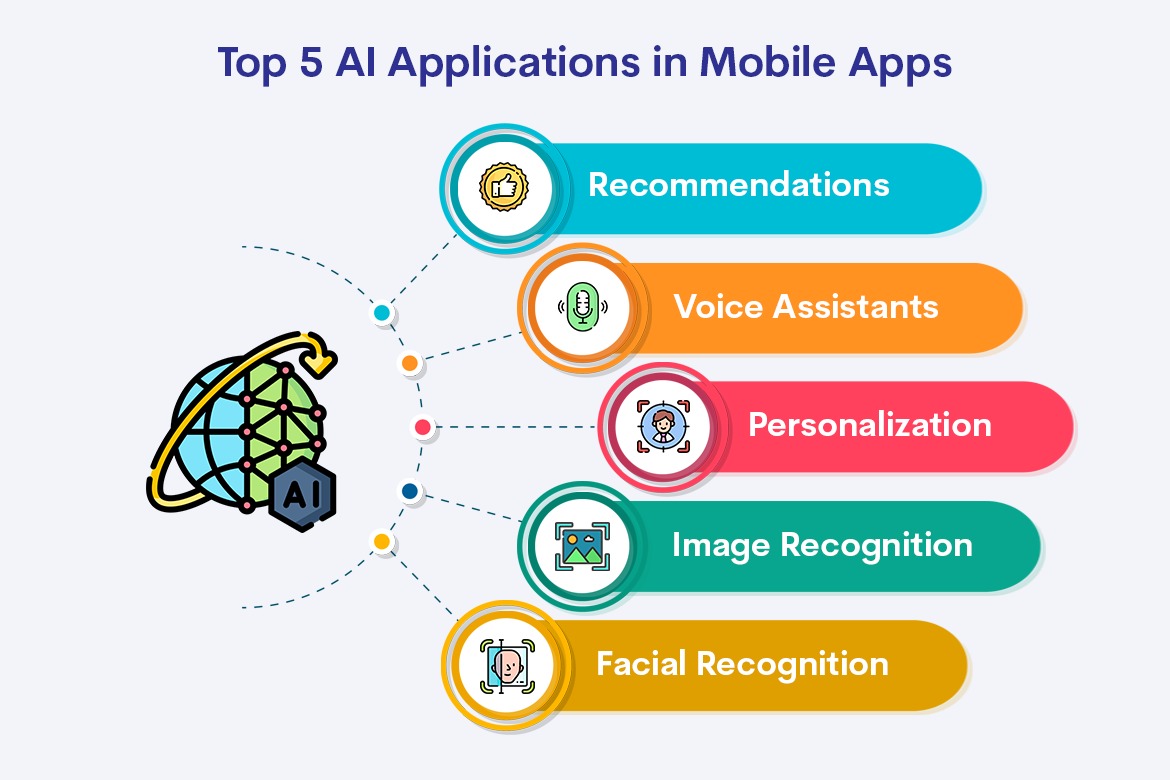
Mobile app development is going on at a fast pace and more and more apps are being launched every day. However, gone are the days of generic services. We have gotten so used to machines improving our lives that we take much for granted that our forefathers would have been amazed by if they had a time travel machine. Users will quickly switch between brands or uninstall apps if they do not impress them. This is the reason why very few apps, if any, are being launched without AI and ML to provide a better user experience and that makes you keep returning to the app.
Think about Facebook and why you keep scrolling through it endlessly. Facebook uses ‘proactive detection’ or AI algorithms to learn enough about you to find other related information to keep you hooked. The same goes for Instagram. Think about Netflix and how it considers your viewing habits to make recommendations. Almost all business owners, product managers, and developers are looking at ways that AI could improve the apps that they are building.
Why mobile apps are best suited for AI-based features?
The emergence of the smartphone has changed how most of us interact with digital technologies. Today, almost everyone has a mobile device and connectivity has become more affordable. This reach is what makes AI and mobile apps adjacent technologies.
There are several reasons why mobile apps can support AI
Processing Power: Smartphones today are powerful enough to support complex AI algorithms, allowing for sophisticated analysis and decision-making in real time. This processing power can be harnessed to enable AI-based features such as voice assistants, image recognition, and predictive text.
Sensor Data: Mobile devices have a wealth of sensor data that can be used to power AI-based features. This includes data from cameras, microphones, accelerometers, and GPS sensors, which can be used to create personalized experiences for users.
Personalization: AI in apps can be used to personalize the user experience. By analyzing user behavior, preferences, and habits, mobile apps can provide personalized recommendations, reminders, and notifications that are tailored to the individual user.

Also Read : 3 Major AI Technology Trends in 2023 for Businesses
How to implement AI in your mobile app development?
Before considering using AI in apps, there is a word of caution. You need to pick the right technology, data storage space, and security tools if you want to integrate AI. The real downside of a hastily implemented AI solution could be a drastic decrease in performance.
There are several ways to implement AI in apps, depending on the specific functionality you want to add. Here are some general steps and technologies that mobile app development companies follow when integrating AI technologies into a mobile app:
1. Start by identifying the use case for the AI integration in your mobile app. This could be anything from image recognition and natural language processing to predictive analytics and machine learning-based recommendations. While it is exciting to consider many AI features, it is always recommended to prioritize the issues you want the AI technology to solve. This will prevent unnecessary features from being added.
2. The next is to choose a development platform. There are many development platforms available for integrating AI in apps. Some popular options include TensorFlow, Keras, PyTorch, and Caffe2. Choose a platform that fits your app’s requirements and your team’s skill set.
3. AI relies heavily on data, so you need to know from what sources you can collect your data. This could involve cleaning and normalizing data, as well as labeling data for training machine learning models.
4. Training machine learning models. Once you have collected and prepared data, you can use it to train ML models. There are many techniques for training machine learning models, including supervised learning, unsupervised learning, and reinforcement learning. Your choice of technique will depend on your specific use case.
5. Now it’s time to deploy models to the mobile app. There are several ways to do this, including embedding the model in the app or using a cloud-based API. Another word of caution here, if you are using a sophisticated AI model using specialized knowledge then you might need a custom model. This is because cloud-based APIs are meant to be general purpose. Cloud-based APIs might also have limitations on performance because of latency and throughput.
6. Finally test and iterate. You may need to iterate on your models and algorithms to improve performance.
AI technologies based on app features
Our smartphones use image recognition as a security authentication step. This is a clear indication of how AI is becoming necessary during app development since it helps make processes frictionless for users while providing increasing benefits. However, Artificial intelligence and ML (machine learning) are blanket terms. There are specific technologies required based on the feature you want for your mobile app.
Image and video processing for visual search engines
- Convolutional Neural Networks (CNNs) for object detection and recognition
- Generative Adversarial Networks (GANs) for image and video synthesis
- Recurrent Neural Networks (RNNs) for video analysis and captioning
Natural Language Processing (NLP) for chatbots and voice assistants
- Recurrent Neural Networks (RNNs) for sequence prediction and generation
- Transformer-based models like BERT and GPT for language understanding and generation
- Word Embeddings for semantic analysis and sentiment classification
Predictive analytics for making forecasts
- Decision Trees for classification and prediction
- Random Forests for ensemble learning and feature selection
- Gradient Boosting for boosting the performance of decision trees
A few examples of predictive analytics are apps that manage inventory, such as retail and supply chain management apps, which can use predictive analytics to forecast demand and optimize inventory levels. side-hailing or navigation apps can use predictive analysis to forecast traffic conditions and suggest the most efficient routes for users.
Using AI for Personalization
- Collaborative Filtering for recommending products, music, or movies based on user behavior and preferences
- Content-Based Filtering for recommending products based on their attributes and user preferences
- Hybrid Recommender Systems combining collaborative and content-based filtering for improved accuracy.
AI in Medical Diagnosis
- Convolutional Neural Networks (CNNs) for image-based diagnoses, such as detecting tumors in medical images
- Support Vector Machines (SVMs) for classification tasks, such as diagnosing diseases based on patient symptoms
- Deep Learning models for Electronic Health Record (EHR) analysis and clinical decision support.
Overall, integrating AI into a mobile app requires careful planning, data collection, and model training. By choosing the right development platform and techniques, you can create a powerful and intelligent mobile app that offers a unique user experience.
Businesses across a variety of industries are integrating AI into their mobile Apps. iTech has delivered a number of unique solutions for global customers such as visas.ai for immigration attorneys in the USA. This application helps to cut down the documentation time and improves the success rate.
If you want to make your app intelligent using AI then you need a reliable technology partner. Reach out to our team at iTech to discuss your requirements. We have a vast portfolio of mobile apps developed using the latest AI and machine learning technologies.







